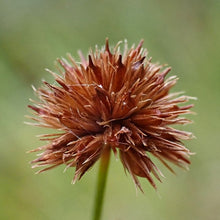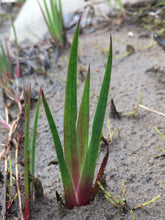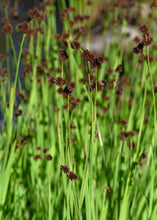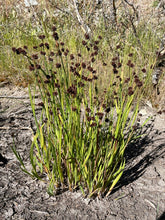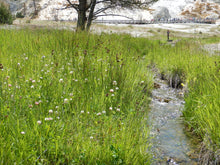
Juncus ensifolius
Dagger-leaf Rush gets its name from its slender iris-like flat blades that create compact clumps of upright foliage in a rain garden or creekside landscape. In spring, it showcases dense tufts of vibrant green foliage, which become adorned by inconspicuous flowers at the tips of its stems which, although not showy, attract and support small bees and other flying insects. By late summer, flowers mature into spiked seed capsules that are oddly ornamental and become an important food source for seed-eating song birds such as Golden-crowned Sparrows and Dark-eyed Junco. Then, its foliage turns golden-brown offering attractive texture, valuable food and shelter resources for insects and other wildlife and natural erosion control in the winter months.
- Plant type/canopy layer: evergreen, perennial, herbaceous plant
- Size at maturity: 12-24” tall; spreads laterally by clumping rhizomes
- Light requirements: prefers full sun, tolerates partial shade
- Moisture requirements: moist to wet soil, but not standing water
- Bloom time: seed pods July - September
- Growth rate/ease: grows quickly, very easy to grow
- Wildlife support: flowers attract and support small bees and other flying insects, seeds provide critical food source for many species of birds; evergreen vegetation provide important shelter in the winter months
- Native habitat/range: commonly found in bogs, marshes, wetlands, and along streambanks or pond edges across western North America. Portland Plant List - yes.
- Special features & uses: groundcover; the plant's stems can be harvested for weaving materials, as they are flexible yet sturdy, making them ideal for crafting items like baskets, mats, and ropes; some online sources note that seeds, rhizome and young shoots this species may have been harvested for food, but not as a primary food source (always do your own research and exercise caution when foraging for wild foods); landscape uses include raingardens, pond edges, erosion control and bank stabilization
Gardening with Dagger-leaf Rush: Plant dagger-leaf rush in a full to mostly sunny area with moist to wet soil, such as a raingarden or bioswale, to take advantage of this plant’s extraordinary ability to filter run-off and stabilize soils. Note however, although this plant adores wet soil, it does not tolerate long periods of standing water. So make sure the landscape area does drain between rain events. It will spread aggressively by rhizomes throughout areas where needed moisture is present, naturally stopping its creep where the saturated soil ends. This creates maximum habitat benefits and a beautiful visual effect when the plant is covered in its attractive seed capsules.
Photo Credit 1 (seed head, closeup): © Chloe and Trevor Van Loon, some rights reserved (CC-BY)
Photo Credit 2 (new plant): © Jeffrey Lee (he/him/his), some rights reserved (CC-BY)
Photo Credit 3 (wild, fruiting population): "Juncus ensifolius kz09" by Krzysztof Ziarnek, Kenraiz is licensed under CC BY-SA 4.0.
Photo Credit 4 (late season clump): © Matt Berger, some rights reserved (CC-BY)
Photo Credit 5 (in the wild): © Matt Lavin, some rights reserved (CC-BY)





